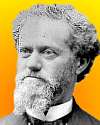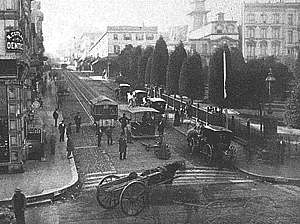 (source)
(source)
|
Andrew Smith Hallidie
(16 Mar 1836 - 24 Apr 1900)
English-American engineer and inventor who built the cable car system first used on the steep hills of San Francisco streets.
|
The Practical Hero of Invention
Andrew Smith Hallidie
From Heroes of California: The Story of The Founders of the Golden State (1910)
[p.317] ONE of the essential features of the California spirit is the ability to think for oneself, to refuse to be held by the thoughts and methods of the past, to meet new problems in new ways. This spirit was well exemplified by the way A. S. Hallidie, of San Francisco, grappled with the transportation problem. The city of the Golden Gate is a very hilly city, and yet some of the finest building sites are on the steep slopes or summits of these hills. Even to-day, when millions of dollars have been spent in cutting and paving streets on these hills, it would be almost an impossibility to use many of the best sites if there were no cheap and easy means of public transportation. The ordinary horse-car could never have scaled these steep grades, and even had horses been found capable of ascending them, it is doubtful whether passengers could have been found brave enough to risk their lives in making the descent. Something had to be invented to meet the necessity, for, as yet, the powers of electricity were not applied to the street-car as they are to-day. At this juncture Mr. Andrew Smith Hallidie turned his inventive energies to the problem, and those who knew him realized that it was as good as settled, for both he and his father were natural inventors, and both were interested in the solving [p.318] of just such problems. As early as 1835 his father had patented his invention of making ropes and cables from iron and steel wire, and in 1855, when Andrew himself was but nineteen years old, he had shown his own power by designing and constructing an aqueduct, suspended on a wire, with a span of two hundred and twenty feet, across the middle fork of the American River. In the mines there was a growing demand for wire rope, and Andrew determined to supply it. In June, 1856, he extemporized hand machinery for making wire rope, and produced the first wire cable made on the Pacific Coast. The following year he established a manufactory for wire ropes in San Francisco.
Then, for several years, he built wire suspension bridges, as well as made cables for use in the mines, — where it was found far more reliable than ordinary rope to haul up the cars loaded with ore and miners from the depths. In 1867 he took out a patent for a rigid suspension bridge, and the same year invented and put into use another contrivance for conveying freight over a mountainous country by means of an overhead continuous wire rope. This was soon known as the “Hallidie Rope-way,” and is largely in use throughout the country. By its means timbers, fuel, tools, provisions and all kinds of supplies are transported to the mines, and in the returning cages or buckets ore is sent to the mill. Mr. Hallidie’s genius had many problems to solve in making this rope-way the complete and satisfactory thing it is to-day, one of the chief of which was the grip pulley. By means of this pulley, — which, [p.319] as its name implies, grips the cable, — power is applied to move the cable, and then, if its speed becomes too great, the same power becomes a brake to restrain it. Another important feature is the gearing, which allows the heavy loads of ore descending to pull up the supplies, etc., ascending, in this way utilizing all the natural power possible.
One of the longest rope-ways in use is four miles long, between stations two miles apart. At Mineral King the stations are six thousand feet apart, and the mine is one thousand nine hundred feet above the mill. In one place the span is seven hundred feet between posts, and the cable crosses a canyon six hundred feet above the bottom.
While thus busy constructing these rope-ways, Mr. Hallidie was daily seeing the need of improved street railway transportation in San Francisco. Horse-cars were in use up some of the lesser inclines, and almost daily his heart was wrenched by witnessing the painful efforts of the struggling horses to drag their loaded cars up these hills. Accidents happened with alarming frequency, for sometimes the horses would lose their footing and the brakes being unable to hold the load, the cars would either rush forward upon them, or drag them back as their weight took them to the foot of the hill. But an endless cable, carrying moving cages of rock, in the country, was an entirely different thing from an endless cable, carrying moving cars, filled with human passengers, suspended in the streets of a city The feature of suspension must be eliminated, and the principle of the endless wire cable applied to a railway [p.320] on the street level. It was in 1871 that the idea was clear to Mr. Hallidie how it might be done. A model was made and patented. Then came the long, tedious, and often disheartening time spent in experimenting and perfecting his invention. Three capitalists in San Francisco generously came forward and supplied the needed funds for the purpose, by subscribing twenty-two thousand dollars each, and in two years’ time, a cable was successfully laid in an underground conduit, propelled by powerful machinery at a fixed station, and street cars moved by it. This was the Clay Street Cable Railroad. The grips are quite common now, but they required many months of trying experiment before they were perfected. It is no light strain to have a grip attached to a street-car, heavily loaded with passengers, even on a level track, much less up a steep incline, suddenly seize a moving cable, fasten on to it, and thus overcome the inertia and take the car along. Grips used to break and cables wear out with alarming rapidity before the present method was adopted. On August 1, 1873, the Clay Street Railway was set in successful operation, and at once demonstrated a success. The Hallidie method became known and was used throughout the world. It worked a complete revolution in streetcar service, and indeed was the most important of all inventions applied to street transportation until the electric car came upon the scene.
When Professor Lowe constructed the Mount Lowe Railway, the question arose as to how the steep sixty-two per cent, grade of the incline should be overcome. [p.321] Here Mr. Hallidie’s genius, combined with that of Professor Lowe, designed the balanced cars on the endless cable and the grip sheave, with its seventy jaws, each of which automatically seizes the cable as it revolves. The result is a perfectly successful and safe device which has now been in operation, without the faintest suggestion of an accident, since 1893. The operation of this cable incline is entirely different from that of a cable street railway. In the latter the cable is gripped from the car, and the movement of the car depends upon the security of the grip’s hold upon the cable. On the Mount Lowe incline, on the other hand, the cable and the car are built together, — the one firmly fastened to the other; the machinery above merely moves the cable, the latter taking the two cars along as it moves.
As Mr. Hallidie’s invention was designed to meet peculiar California necessities, and it is in most successful operation, with a variety of local adaptations, in the State, I have thus preferred to take and use it as an example of inventive skill used for the benefit of the people, rather than some other and more general application of inventive power.
- Science Quotes by Andrew Smith Hallidie.
- 16 Mar - short biography, births, deaths and events on date of Hallidie's birth.
- 1 Aug - short biographies, births, deaths and events on date of cable car service inauguration.
- Cable Car Days in San Francisco, by Edgar Myron Kahn. - book suggestion.





